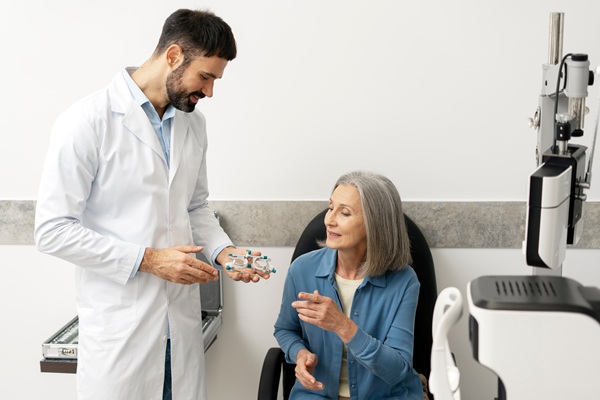Can Optometry Detect General Health Problems?

Optometry is a field of medicine that focuses on the eyes. Optometrists are doctors who specialize in this field. They work to detect, diagnose, manage, and treat conditions of the eyes. However, what may be surprising to learn is that, just by examining the eyes, optometry can also detect general health problems.
In this article, discover how optometry can detect health problems that affect the entire body. Read about a few common conditions that may be detectable by an optometrist during a simple eye examination. This information can be useful for knowing what to expect when visiting an optometry office.
Can optometry detect general health problems?
Optometry can detect much more than what most people realize. The average person may think that an optometrist can only identify and diagnose problems related to eyes; however, this is far from the truth! Optometry is indeed the study of the eyes, but the doctors who specialize in this field can detect a wide range of general health problems, many of which have nothing to do with the eyes.
General health problems that can be detected through optometry
The following goes over a few of the most common health problems that optometrists can detect through an eye examination.
Diabetes
Diabetes is one of the most common diseases that people suffer from. It is a collection of issues that affect a person's blood sugar levels. When visiting an optometry office for an exam, the eye doctor may be able to detect diabetes through an examination of the capillaries of the retina. Leaking blood or fluid may indicate that diabetes is present, for example.
Cancer
Even if cancer has spread to another part of the body, the eyes are often the first organ to show signs of trouble. Any kind of cancer, from skin to blood, is detectable with a simple eye exam. Leukemia may manifest as hemorrhaging inside the retinas, while ocular melanoma can manifest as a change in eye color. During an eye exam, the doctor will examine the area surrounding the eyes for any changes that could indicate a more serious problem, such as new or unusual freckling or dark patches.
Arthritis
Dry eyes, which may be a symptom of another issue, are readily detectable with an eye exam at the optometrist's office. One in four people with rheumatoid arthritis report having dry eyes. The degree to which one has dry eyes may vary from annoying to life-threatening. Rheumatoid arthritis is also characterized by iritis, or inflammation of the iris. Two such flare-ups within a year or three within 18 months are highly suggestive of rheumatoid arthritis. Patients may also develop glaucoma and cataracts and have eye discomfort, sensitivity to light, blurred or impaired vision, and other visual problems if they have inflammatory arthritis.
Stroke
An optometrist can learn much about a patient's risk for stroke and overall health by looking at the state of their retinas. Stroke risk indicators include microbleeds or other vascular damage in the retina. The optometrist will likely diagnose this situation to be the result of high blood pressure and recommend preventative actions.
High cholesterol
If the eye doctor notices that the cornea has a yellow color or tint to it, this may be a sign of high cholesterol. Plaques in the retina of the eye may also indicate high cholesterol, and high cholesterol levels signal that the patient should visit their primary care physician for further care.
Hypertension
High blood pressure is a common health problem that many people deal with. Optometry can detect it through a close-up examination of the eyes. Any noticeable tears, breaks, or unevenness in the blood vessels may indicate an elevated blood pressure, which should be immediately addressed by a health care professional.
Get started with an optometrist today
Optometry can detect many different general health problems, which is one of the many reasons that annual eye exams are so important. Eye doctors can examine the eyes for any noticeable symptoms that could indicate a disease within the eyes or in the whole body.
If you have queries about optometry or detecting general health problems, please reach out to our office so we can better assist you. We can answer any questions that you might be wondering about or address any concerns that you might have. Our team would be happy to hear from you in any way, so get started today!
Request an appointment here: https://www.texasoptical.net or call Texas Optical at (214) 771-7333 for an appointment in our Dallas office.
Check out what others are saying about our services on Yelp: Optometry in Dallas, TX.
Recent Posts
Red, itchy eyes can affect your everyday comfort and reduce overall well-being. It is important to seek effective vision care from the first sign of irritation. Proper attention to symptoms, underlying causes, and healthy habits ensures stronger long-term eye health and greater day-to-day clarity. Redness and itchiness often stem from several common triggers. These include: Allergic…
New spots or shadows drifting across vision can be unsettling, and sudden changes sometimes require emergency eye care to protect long-term sight. Many floaters are harmless, but others signal serious problems with the retina or internal eye structures. Understanding when floaters are normal and when they point to a true eye emergency helps patients act…
Glaucoma treatment plays a vital role in preserving vision and protecting the optic nerve from further damage. Many patients rely on daily eye drops to manage intraocular pressure, but these medications can sometimes come with side effects. Understanding how to recognize, minimize, and communicate about these effects supports long-term success and comfort with treatment. While…
Progressive lenses offer clear vision at near, arm's length, and far distances without the visible lines found in bifocals. They provide a smooth change in power from top to bottom, which means the eyes can focus comfortably throughout the day. With the right fit and guidance from an optometrist, progressive lenses help reduce eye strain…


